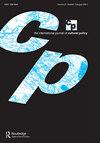Tracing the Atom. Nuclear Legacies in Russia and Central Asia
IF 1.6
3区 社会学
Q2 CULTURAL STUDIES
引用次数: 1
Abstract
certainly relevant. Finally, and again relatedly, the volume exhibits the ever-so-familiar tendency or attempt to valorise and thus implicitly legitimise one’s own research topic. This comes across particularly forcefully in Vuletic’s introduction (ch. 1), but elsewhere as well. ‘Eurovision entries are multimodal social-semiotic acts of communication that incorporate aural, visual, technological, linguistic, textual and performative facets’, laud Alison Lewis and John Hajek in their largely descriptive account of an online course with superfluous irrelevant technical details (70). I daresay, so is every occasion I put a vinyl on a turntable with friends present. Yes, it is curious how the ESC has evaded the attention of scholars of popular music, media and culture alike. The why is, to me at least, somewhat obvious, especially when it comes to music scholars: until the twenty-first century, the field was obsessed with rockist notions of authenticity, thus rendering the really popular music unworthy of attention. In 1992, Finland was represented in the ESC by Pave (Maijanen), a key figure in the history of Finnish rock music since the early 1980s, yet finishing last, though not with nul but quatre points. The title of the song includes most of its lyrics, qualitatively at least. The performance is available online (https://www.youtube.com/watch?v= n-PhSnk-omM) so those wishing to do so may check if their reaction is as multifaceted as mine, combining feelings and sensations of nostalgia, joy, embarrassment, naïvety, and the urge to get up and dance. I do not flag. Yamma yamma.跟踪原子。俄罗斯和中亚的核遗产
当然有关。最后,同样相关的是,这本书展示了人们所熟悉的趋势,或试图使自己的研究主题增值,从而隐含地使自己的研究主题合法化。这在Vuletic的介绍(第1章)中表现得尤为强烈,但在其他地方也是如此。Alison Lewis和John Hajek在他们对一门在线课程的大量描述中称赞道:“欧洲歌唱大赛的参赛作品是一种多模态的社会符号学行为,融合了听觉、视觉、技术、语言、文本和表演等方面。”我敢说,每次我在朋友在场的情况下把黑胶唱片放在唱盘上也是如此。是的,ESC是如何避开流行音乐、媒体和文化学者的关注的,这很奇怪。至少对我来说,原因是显而易见的,尤其是当涉及到音乐学者时:直到21世纪,这个领域一直痴迷于摇滚主义的真实性概念,从而使真正流行的音乐不值得关注。1992年,芬兰由Pave (Maijanen)代表参加了ESC,这是自20世纪80年代初以来芬兰摇滚音乐史上的关键人物,但最后一名,尽管不是零分,而是四分之一分。这首歌的标题包含了它的大部分歌词,至少在质量上是这样。这个表演可以在网上观看(https://www.youtube.com/watch?v= n-PhSnk-omM),所以那些希望观看的人可以看看他们的反应是否和我一样是多方面的,结合了怀旧、喜悦、尴尬的感觉,naïvety,以及站起来跳舞的冲动。我不打旗子。美洲驼美洲驼。
本文章由计算机程序翻译,如有差异,请以英文原文为准。
求助全文
约1分钟内获得全文
求助全文

 求助内容:
求助内容: 应助结果提醒方式:
应助结果提醒方式:


